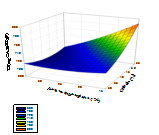Optimisation of Encapsulation by Complex Coacervation of Phenolic Compounds from Propolis with Triumfetta cordifolia Gum and Kinetic Study
http://www.doi.org/10.26538/tjnpr/v7i3.21
Keywords:
Triumfetta cordifolia gum, propolis, phenolic compounds, EncapsulationAbstract
Phenolic compounds from propolis have pharmacological properties such as antioxidant, antidiabetic, antiulcer, anticancer. However, they are unstable and oxidize in contact with ultraviolet rays and humidity. In order to limit their oxidation, phenolic compounds need to be protected through a polymeric membrane. The aim of this work is to optimize the encapsulation of phenolic compounds from propolis by complex coacervation using a polymer matrix consisting of gelatin and a Cameroonian tropical gum named Triumfetta cordifolia. A second order regression using Central Composite Design (CCD) was used to determine the optimal conditions of encapsulation as follows: pH (X1) 4.2, gelatin concentration (X2) 54 % and active ingredient concentration (X3) 25 %. The use of Triumfetta cordifolia gum as an anionic polymer led to a considerable encapsulation rate of total polyphenols and flavonoids with the values of 85.75 % and 88.24 % respectively. Concerning the study of the release kinetic of phenolic compounds from propolis, it appeared that the zero-order model better fitted the release in the
gastric environment with a high correlation coefficient of R2 = 0.99. While in the intestinal environment it was the first-order model which better explained their slowed diffusion into the solvent (R2= 0.97).
References
AL-Ani I, Zimmermann S, Reichling J, Wink M. Antimicrobial Activities of European Propolis Collected from Various Geographic Origins Alone and inCombination with Antibiotics. Medicines. 2018; 5(1). https://doi.org/10.3390/medicines 5010002.
Tagne MAF, Noubissi PA, Tchoblaouna KJT, Fankem GO, Rékabi Y, Akaou H, Fohouo FNT. Effects of Hydroethanolic Extract of Cameroonian Propolis (Promaxc) on Castor Oil-Induced Diarrhea in Mice. World J. Adv. Res. Rev. 2020; 7(3):194–203.
Talla E, Nyemb JN, Tiabou AT, Djou SGZ, Biyanzi P, Sophie L, Tanyi JM. Antioxidant Activity and a New Ursane-Type Triterpene from Vitellaria Paradoxa (Sapotaceae) Stem Barks. Eur. J. Med. Plants. 2016; 1–20.
Freires IA, Queiroz VCP, Furletti VF, Ikegaki M, De Alencar SM, Duarte MCT, Rosalen PL. Chemical Composition and Antifungal Potential of Brazilian Propolis against Candida Spp. J. Mycol.Médicale. 2016; 26(2):22– 132.
Bankova V. Chemical Diversity of Propolis and the Problem of Standardization. J. Ethnopharmacol. 2005; 100 (1–2):114–117.
Sakava P, Talla E, Chelea M, Tchinda TA, Laurent S, Tagatsing FM, Yaya GAJ, and Atchade DT. Pentacyclic Triterpenes and Crude Extracts with Antimicrobial Activity from Cameroonian Brown Propolis Samples. J. Appl. Pharm. Sci. 2014; 4(7):1-9.
Magnavacca A, Sangiovanni E, Racagni G, Dell’Agli M. The Antiviral and Immunomodulatory Activities of Propolis: An Update and Future Perspectives for Respiratory Diseases. Med. Res. Rev. 2022; 42(2):897–945.
Mouhoubi-Tafinine Z, Ouchemoukh S, Tamendjari A. Antioxydant Activity of Some Algerian Honey and Propolis. Ind. Crops Prod. 2016; 88:85–90.
Pratami DK, Indrawati T, Istikomah I, Farida S, Pujianto P, Sahlan M. Antifungal Activity of Microcapsule Propolis from Tetragonula spp. to Candida Albicans. Commun. Sci. Technol. 2020; 5 (1):16–21.
Usman UZ, Bakar ABA, Zin AAM, Mohamed M. LC-MS Analysis and Effects of Malaysian Propolis on Insulin,
Glucagon, Pancreas and Oxidative Stress Status in Streptozotocin-Induced Diabetic Rats. J. Med. Biomed. Res.
; 16(1):15–27.
Haminiuk CWI, Plata-Oviedo MSV, De Mattos G, Carpes ST, Branco IG. Extraction and Quantification of Phenolic Acids and Flavonols from Eugenia Pyriformis Using Different Solvents. J. Food Sci. Technol. 2014; 51 (10): 2862–2866.
Siow LF and Ong CS. Effect of PH on Garlic Oil Encapsulation by Complex Coacervation. J Food Process Technol 2013; 4 (1).1-5.
Lazko J, Popineau Y, Legrand J. Soy Glycinin Microcapsules by Simple Coacervation Method. Colloids Surf. B Biointerfaces 2004; 37(1–2):1–8.
Yan C, Zhang W. Coacervation Processes. In Microencapsulation in the food industry. 2014; 125–137.
De Souza JRR, Feitosa JP, Ricardo NM, Trevisan MTS, De Paula HCB, Ulrich CM, Owen RW. Spray-Drying
Encapsulation of Mangiferin Using Natural Polymers. Food Hydrocoll. 2013; 33(1):10–18.
Adejoro FA, Hassen A, Thantsha MS. Characterization of Starch and Gum Arabic-Maltodextrin Microparticles Encapsulating Acacia Tannin Extract and Evaluation of Their Potential Use in Ruminant Nutrition. Asian-Australas. J. Anim. Sci. 2019; 32(7):977-987.
Azevedo de M. Oliveira LF, Teles da Silva LVA, Nascimento TG, De Almeida LM, Calumby RJN, Nunes ÁM, De Magalhães Oliveira LMT, Da Silva Fonseca EJ. Antioxidant and Antimicrobial Activity of Red Propolis Embedded Mesoporous Silica Nanoparticles. Drug Dev. Ind. Pharm. 2020; 46 (7): 1199–1208.
Kamdem IEN, Saidou C, Ngassoum MB, Ndjouenkeu R. Synergistic Interactions in Dilute Aqueous Solutions between Alginate and Tropical Vegetal Hydrocolloids. Heliyon 2020; 6 (7): e04348.
Maroof K, Gan SH. A Review on Chemical Compositions, Biological Activity and Formulation Techniques of
Malaysian Honey Bee and Meliponine Propolis. J. Biol. Act. Prod. Nat. 2020; 10 (6): 507–523.
Živković IP, Jurić S, Vinceković M, Galešić MA, Marijan M, Vlahovićek-Kahlina K, Mikac KM, Lemic D. Polyphenol-Based Microencapsulated Extracts as Novel Green Insecticides for Sustainable Management of Polyphagous Brown Marmorated Stink Bug (Halyomorpha Halys Stål, 1855). Sustainability. 2020; 12 (23):10079.
Tamfu AN, Sawalda M, Fotsing MT, Kouipou RMT, Talla E, Chi GF, Epanda JJE, Mbafor JT, Baig TA, Jabeen A. A New Isoflavonol and Other Constituents from Cameroonian Propolis and Evaluation of Their Anti-Inflammatory, Antifungal and Antioxidant Potential. Saudi J. Biol. Sci. 2020; 27 (6):1659–1666.

Published
How to Cite
Issue
Section
License
Copyright (c) 2023 Tropical Journal of Natural Product Research (TJNPR)

This work is licensed under a Creative Commons Attribution-NonCommercial-NoDerivatives 4.0 International License.

















